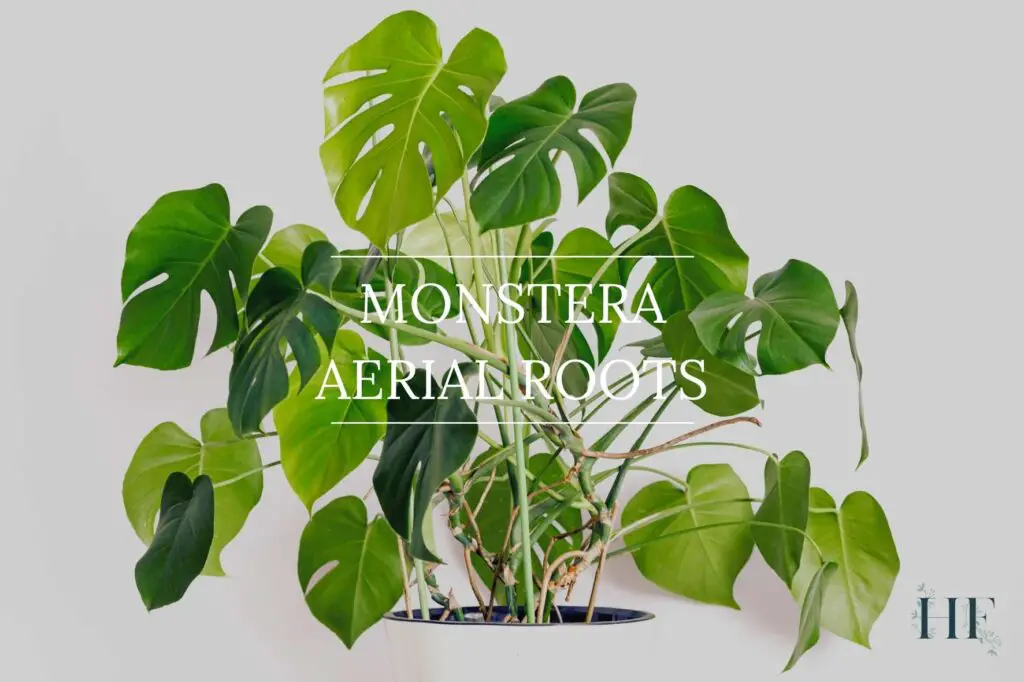What are Monstera aerial roots, and what do you do with them? Here, I’ve compiled a list of the most frequently asked questions among houseplant lovers to shine some light on the matter.
1) What Are Monstera Aerial Roots?
Aerial roots are roots that develop above ground. The aerial roots of a Monstera Deliciosa serve two main purposes or functions: to help anchor the plant to a support, such as a tree or moss pole, and to take up moisture and nutrients from the air.
Eventually, your Monstera Deliciosa will develop very long aerial roots.
It’s key to understand that Monstera plants are epiphytes, meaning they grow on other plants. In their natural habitat, their aerial roots attach to tree trunks and rocks for support and grow higher up to reach brighter light under the dense rainforest canopy.
Unlike the Ivy plant, which is incredibly hard to remove and deteriorates the surface they attach themselves to, Monstera’s aerial roots do not harm the surface they attach to; they are not parasitic plants.
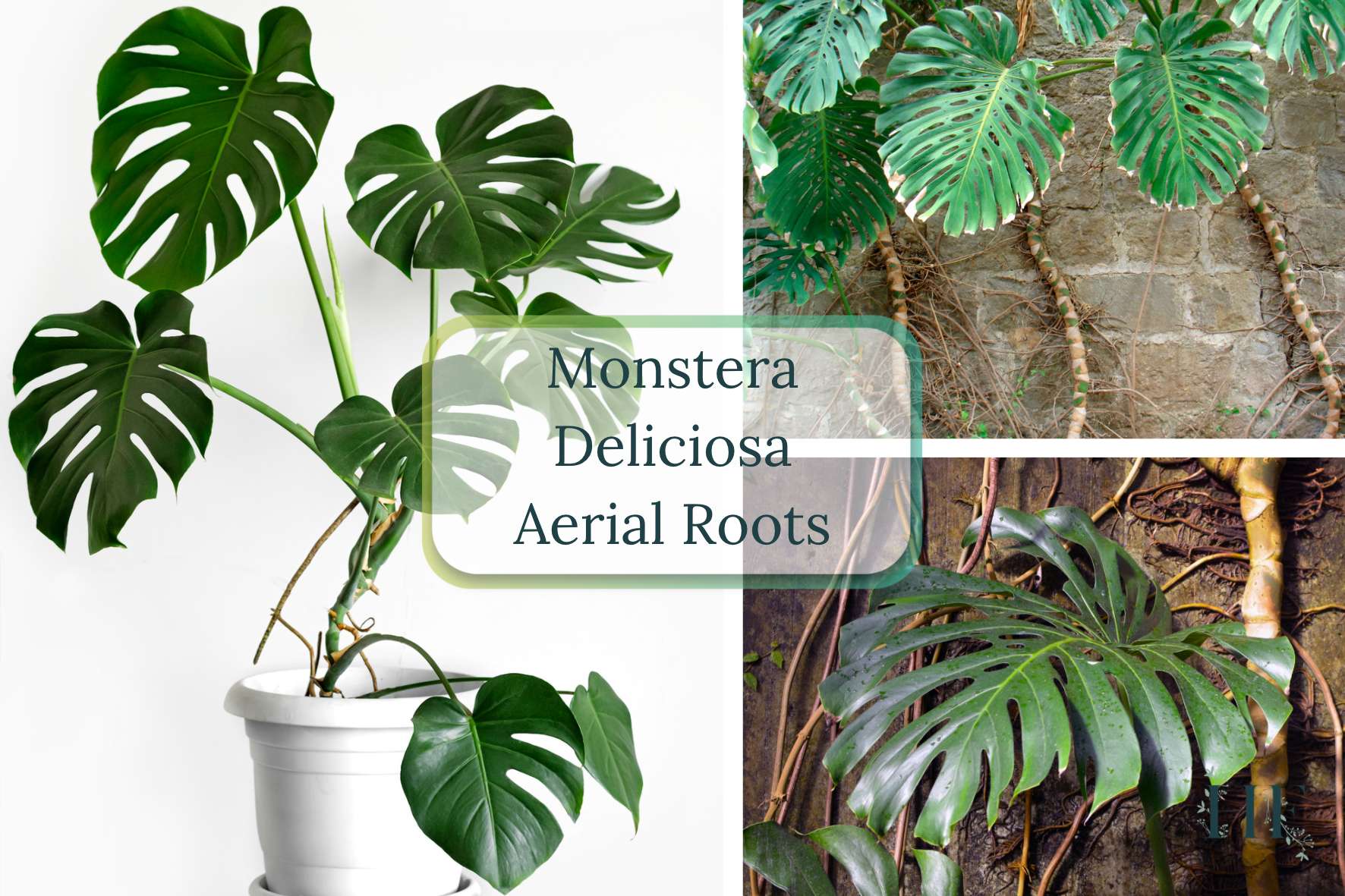
Did you know? In the wild, a mature Monstera Deliciosa can end up relying entirely on its aerial roots. It can lose its connection with the soil and the spot it sprouted from. This makes it a hemiepiphyte: a plant that spends part of its life cycle as an epiphyte (a plant that doesn’t grow in soil but on rocks or other plants in a non-parasitic manner, getting their nutrients from the air and water, rather than from the soil). Their aerial roots can always decide to link back to the soil creating new roots that go downwards.
2) What Do Monstera Aerial Roots Look Like?
An aerial root on your Monstera Deliciosa isn’t too difficult to recognize.
Monstera aerial roots tend to grow out of the plant’s nodes. They begin as small brown knobs that grow from the Monstera’s stem and, over time, can reach several feet in length.
Monstera aerial roots can grow quite thick in the wild, but at home, they tend to stay thin (around 1 centimetre or 0.4 inches in thickness). However, they can grow pretty long and stick out in all directions as your plant looks for support.
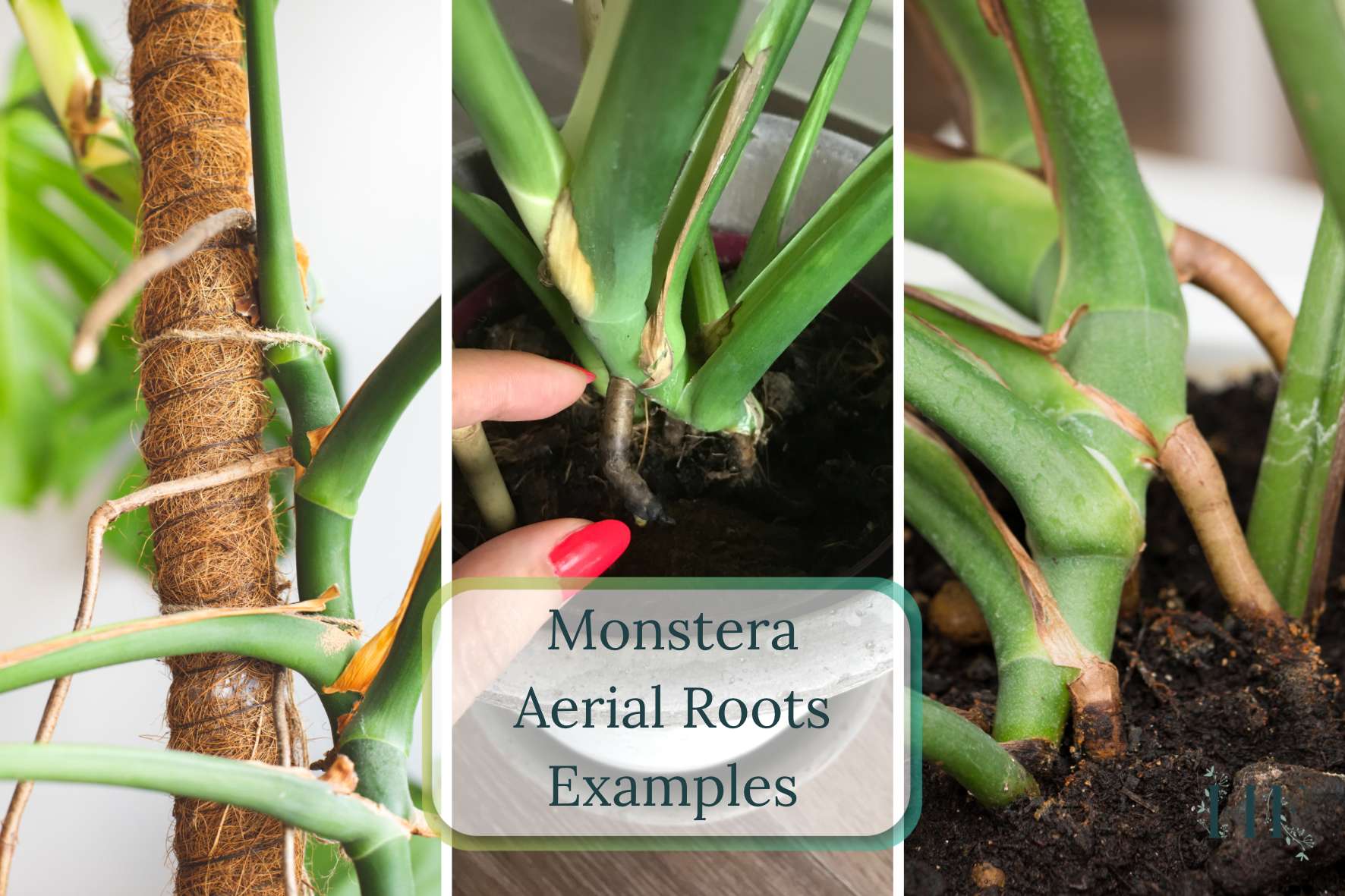
3) What Is the Difference Between Aerial Roots and Lateral Roots?
The Monstera Deliciosa has two root systems – two types of roots that have different functions: aerial roots are mainly for climbing and they grow above the soil; lateral (or underground) roots, however, absorb moisture and nutrients from the soil and grow under the soil.
Most plants (apart from air plants) have lateral roots. Aerial roots are common in many different plants and trees, including some varieties of mangroves, ficus trees, orchids and several varieties of ivy.
Monsteras are hemiepiphyte since their roots go both downwards into the soil and upwards climbing over trees, i.e. they are generally climbing but are also terrestrial.
Did you know? Aerial roots can also absorb some moisture and possibly some nutrients, but much less so than underground roots.
Here’s a look at Monstera’s root system:
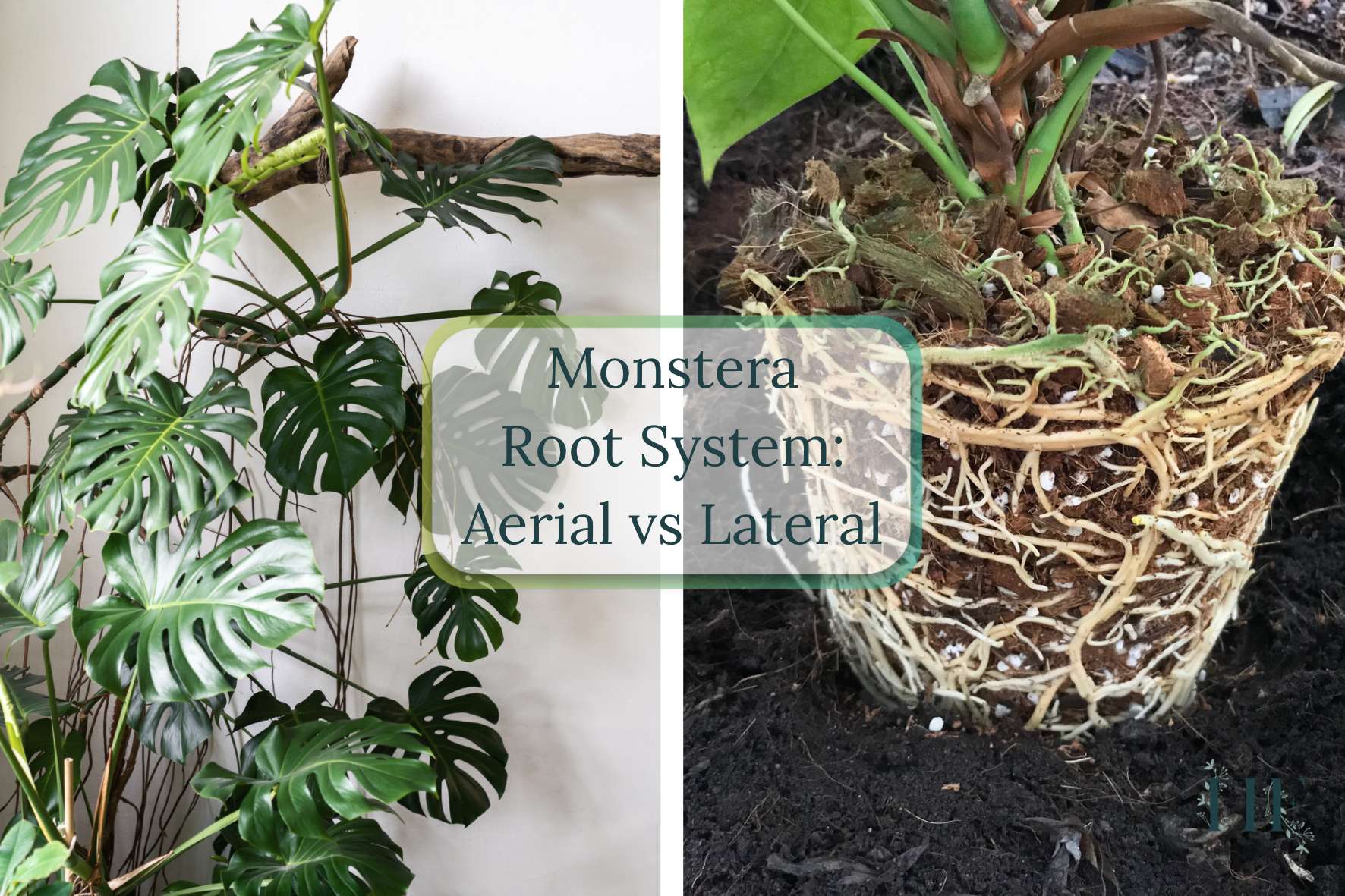
4) What to Do with Monstera Aerial Roots?
A healthy mature Monstera Deliciosa can grow a lot of aerial roots over time, and this can make them look messy and also difficult to pot. It can look like your monstera is climbing out of its planter!
These aerial roots can try to climb up your walls or furniture, which can damage paint and finishes. So, if your monstera’s aerial roots are getting out of control (growing too big and reaching everywhere), you have two options: supporting and pruning.
My monstera hasn’t reached that point yet, but it’s good to know what can be done with those aerial roots whilst it continues to grow healthy.
You can support your Monstera by guiding them into a trellis or moss pole. Some Monstera owners also tuck the aerial roots around the plant, keeping the plant from looking too wild.
Alternatively, if the aerial roots are pilling on the floor, you can prune them so the roots are no longer touching the floor.
I will discuss both options in more depth further down.
Finally, you can just leave the aerial roots alone. Ultimately, this is a matter of personal taste and how you want your Monstera to look.
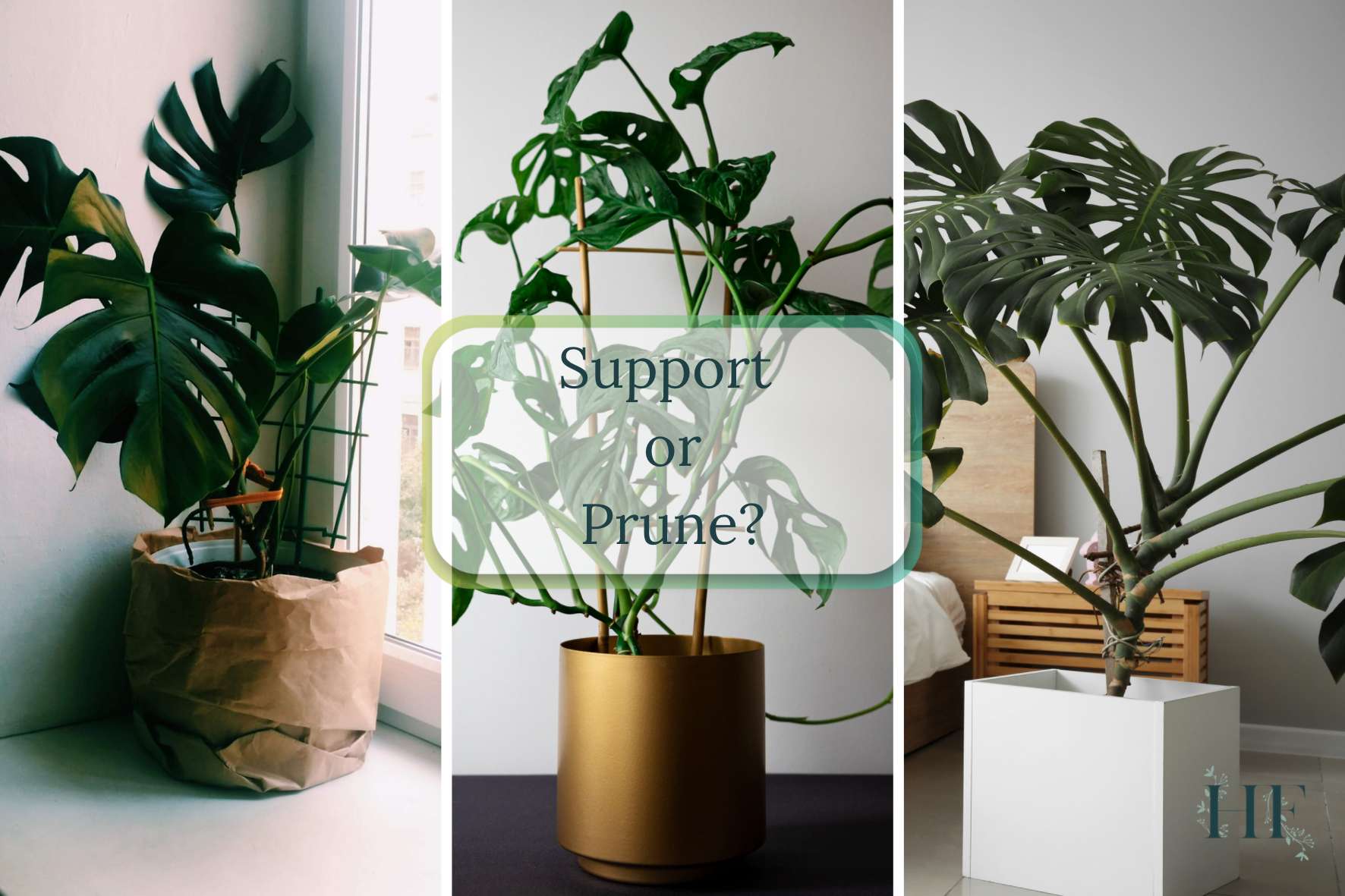
5) Is it OK to Cut Air Roots off Monstera?
Whether you like a neat-looking Monstera or a slightly wilder plant, can you cut monstera aerial roots?
You can prune or trim the aerial roots of your Monstera, and this will not harm your plant. However, expect them to grow back.
To trim back aerial roots, you will need a set of clean, sharp, and sterilized shears. Sanitizing your shears will prevent you from introducing bacteria and fungi that can harm your plant.
Prune your Monstera’s aerial roots back to the stem, cutting just before where the root meets the node or stem.
Insider Tip: When pruning, it’s important that you remove the entire root and not just part of it. Also, you should note that pruning can encourage aerial root growth, resulting in multiple roots popping up where only one was before.
It’s best to prune your Monstera in early spring before the growing season starts.
Finally, cutting the aerial roots isn’t necessarily the best way to grow a big, mature Monstera plant. Aerial roots don’t necessarily take energy away from the plant. The energy that could go into making leaves.
There’s no guarantee that by trimming the aerial roots your Monstera will grow bigger and fenestrated leaves. The opposite can be true, some Monsteras might need a decent aerial root system to grow their leaves past a certain size.
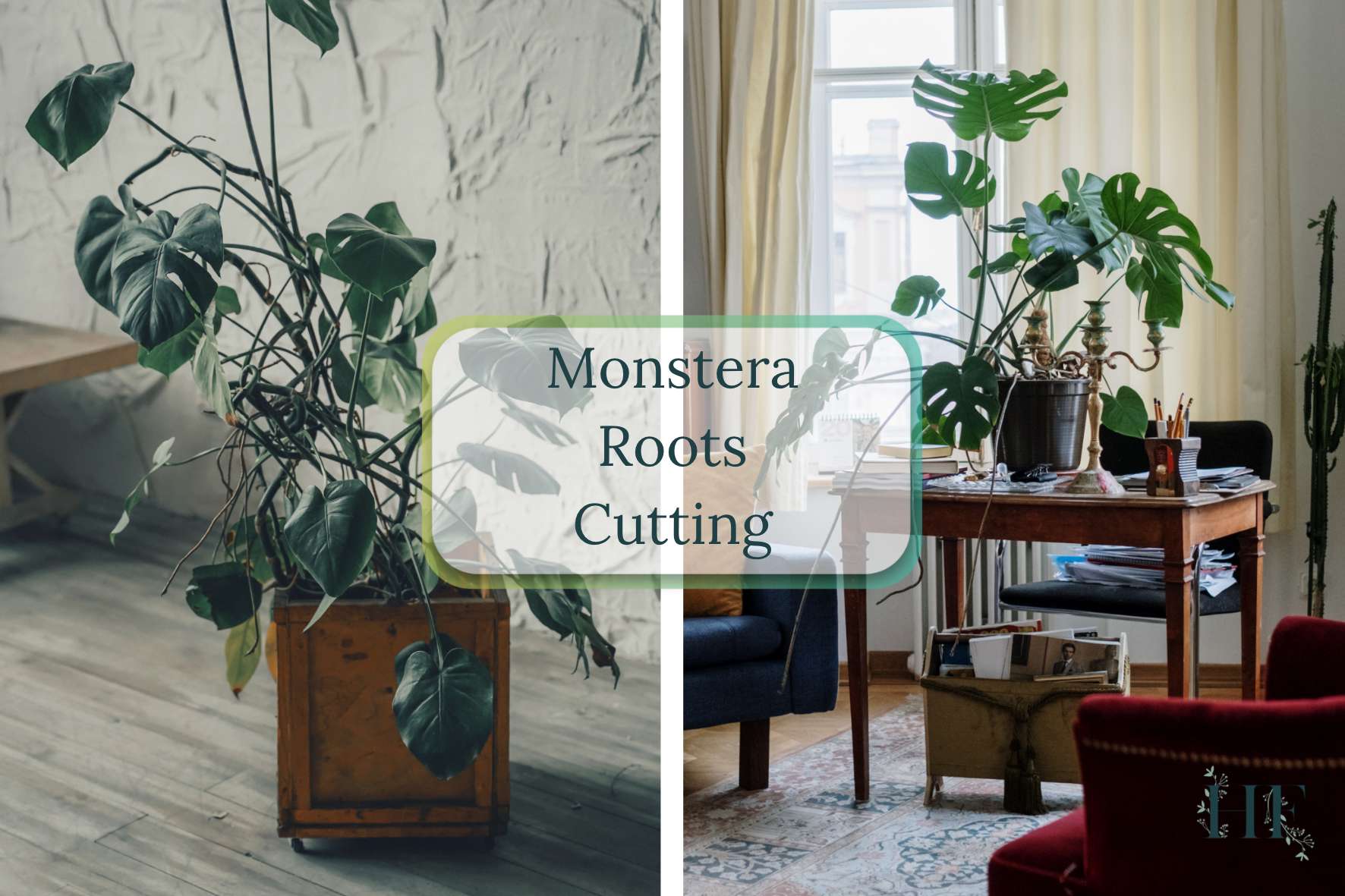
6) How Can I Train Monstera Roots into a Moss Pole?
If the aerial roots aren’t bothering you but you want to help your Monstera along, giving it something to grab onto, a moss pole can be a great support system.
While it is not necessary to train your Monstera on a moss pole, you can simply secure the most mature stem or vine against a moss pole or trellis using a twist tie.
Once the moss pole is in place, it’s as simple as finding the thickest and most mature stems and tying them gently to the pole to encourage the plant’s aerial roots to attach.
Providing your Monstera with a moss pole will encourage its aerial roots to grow towards the pole rather than all over the place, giving your plant a tidier look (see photos below as a reference).
However, you will need to periodically mist the pole to keep it moist. This will make it easier for the aerial roots to grow into the pole. Keeping it moist enough can be a challenge for some, however.
Alternatively, you can make or buy a trellis. But, if you rather not use a moss pole, I use this twist tie (a soft tie that doesn’t damage the vines) to attach my Monstera to a DIY bamboo tripod.
Insider Tip: Regardless of the type of support you choose, make sure its higher than your Monstera, so your plant has some space to grow into.
It is important to note that not providing your Monstera with support can possibly hinder its overall growth and result in heavier stems snapping over time.
Read also: A Guide to Monstera Training – How to Make Them Climb.
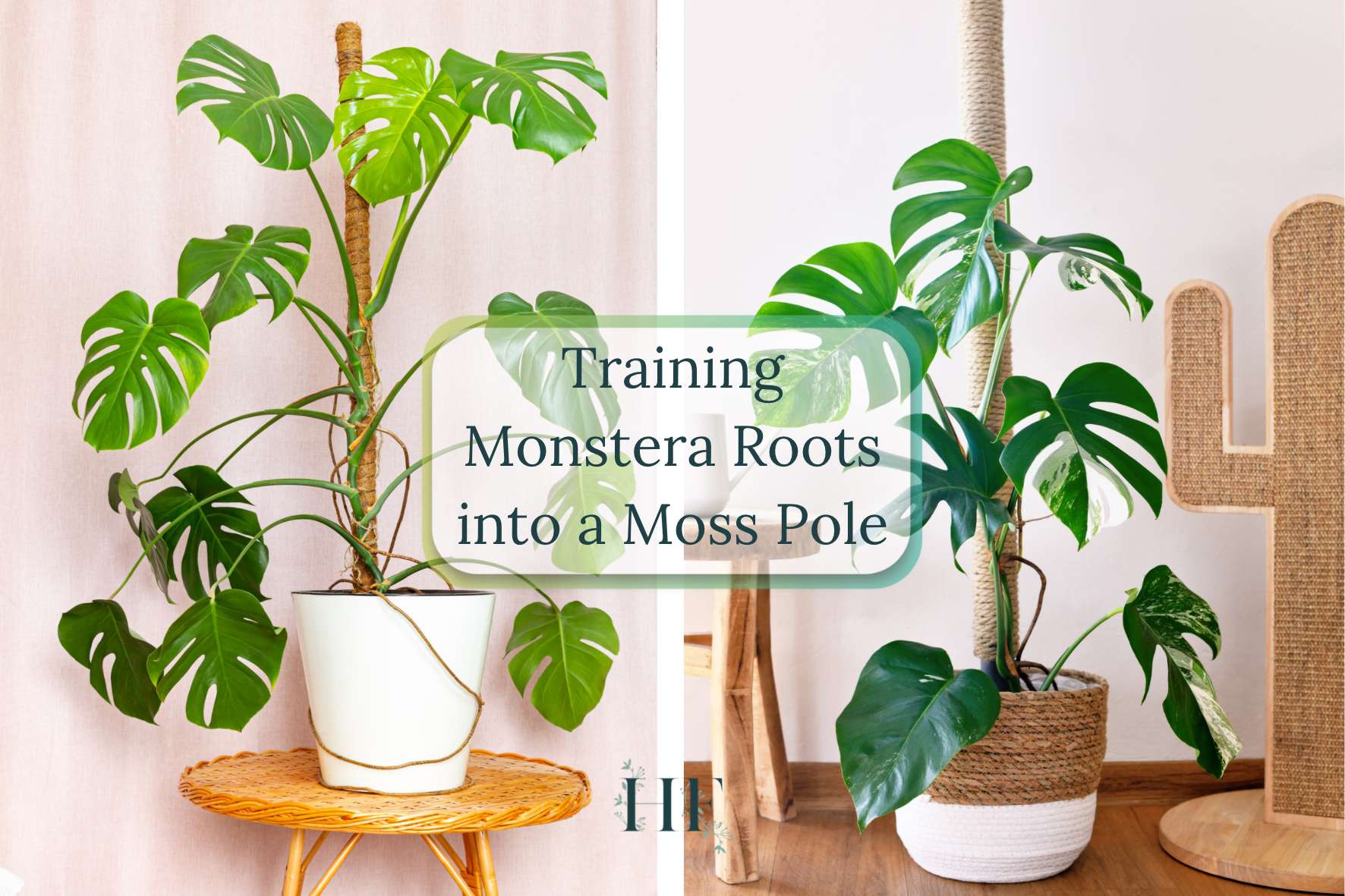
7) Can You Propagate Monstera Aerial Roots?
If you snip off a length of aerial root and submerge it in water, it will probably just rot.
You can not grow or propagate a new Monstera plant from just an aerial root. In order to grow a new plant, you will need a cutting that contains a node (where the leaf meets the vine).
The idea of propagating Monstera aerial roots is likely from the possibility that some Monstera cuttings, which have a node, include an aerial root. But, if you have a node on your cutting that doesn’t have an aerial root, you still have a viable cutting.
8) Why Doesn’t My Monstera Have Aerial Roots?
In most cases, when a Monstera Delciosa doesn’t have aerial roots it probably is because it’s still too young (referred to as a juvenile Monstera). As your plant grows and ages, the aerial roots will appear.
When I got my Monstera, it had no fenestration and no aerial roots. In a year or so, however, some aerial roots started to grow.
9) Should I Put My Monstera’s Aerial Roots in Water?
There’s some talk that putting monstera aerial roots in water will cause the plant to rapidly grow a bunch of new leaves. However, there are some variables to take into account (growing conditions, the type of water used, etc.) and there’s no guarantee that it will work.
Aerial roots evolved to live in the air, not to be submerged in water. Although they can absorb some moisture, they are mostly meant to grab onto surfaces, not sit in water.
Therefore, it’s not necessary to put your Monstera’s aerial roots in water, especially if you follow an appropriate watering routine.
Plus, putting the aerial roots in water can cause rot, will clutter your space and possibly create a hazard too. Personally, I have never misted or put aerial roots in water to keep them healthy.
And, should you mist your Monstera roots?
Misting aerial roots of a Monstera Deliciosa is not necessary either. When training the roots to climb a moss pole, you are mainly misting the pole, not the aerial roots.
The image below is to illustrate how you can propagate a cutting with a node (that also has an aerial root) in water.
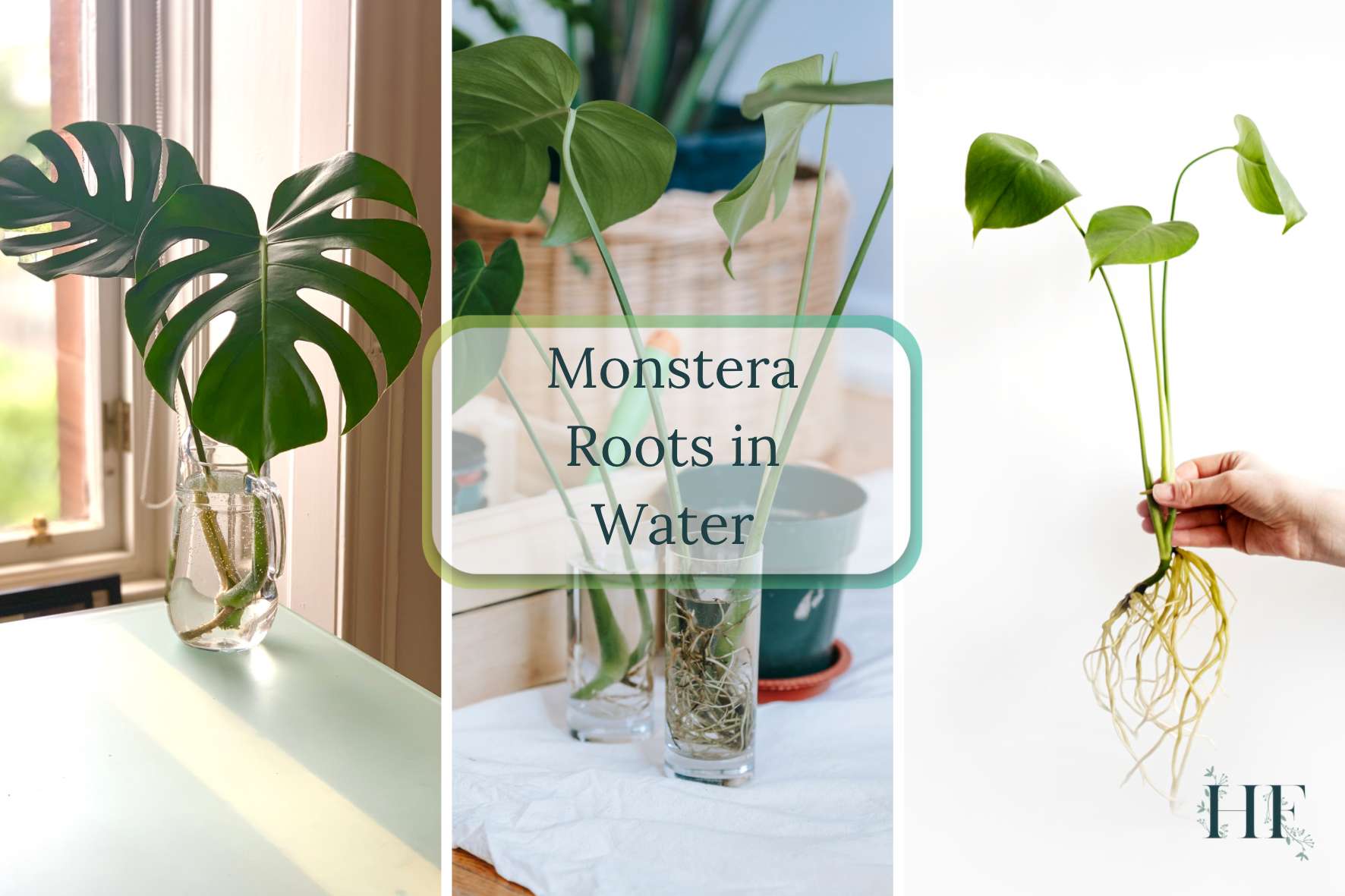
10) Should I Point My Monstera’s Aerial Roots into the Soil?
Similar to the Monstera owners that claimed to put aerial roots in water, others claim to put them in soil.
Aerial roots have evolved to be in the air, however, some aerial roots can decide to grow into the soil by themselves (see image below). If that’s the case, I’d leave it there since it won’t cause any harm and it can provide some stability to the plant.
However, there’s no need to point your Monstera’s aerial roots into the soil.
In the image below, you can see the aerial roots of my Monstera Deliciosa and how some are going into the soil by themselves. Also, you can see the twist tie I use to keep the vines attached to the bamboo poles.
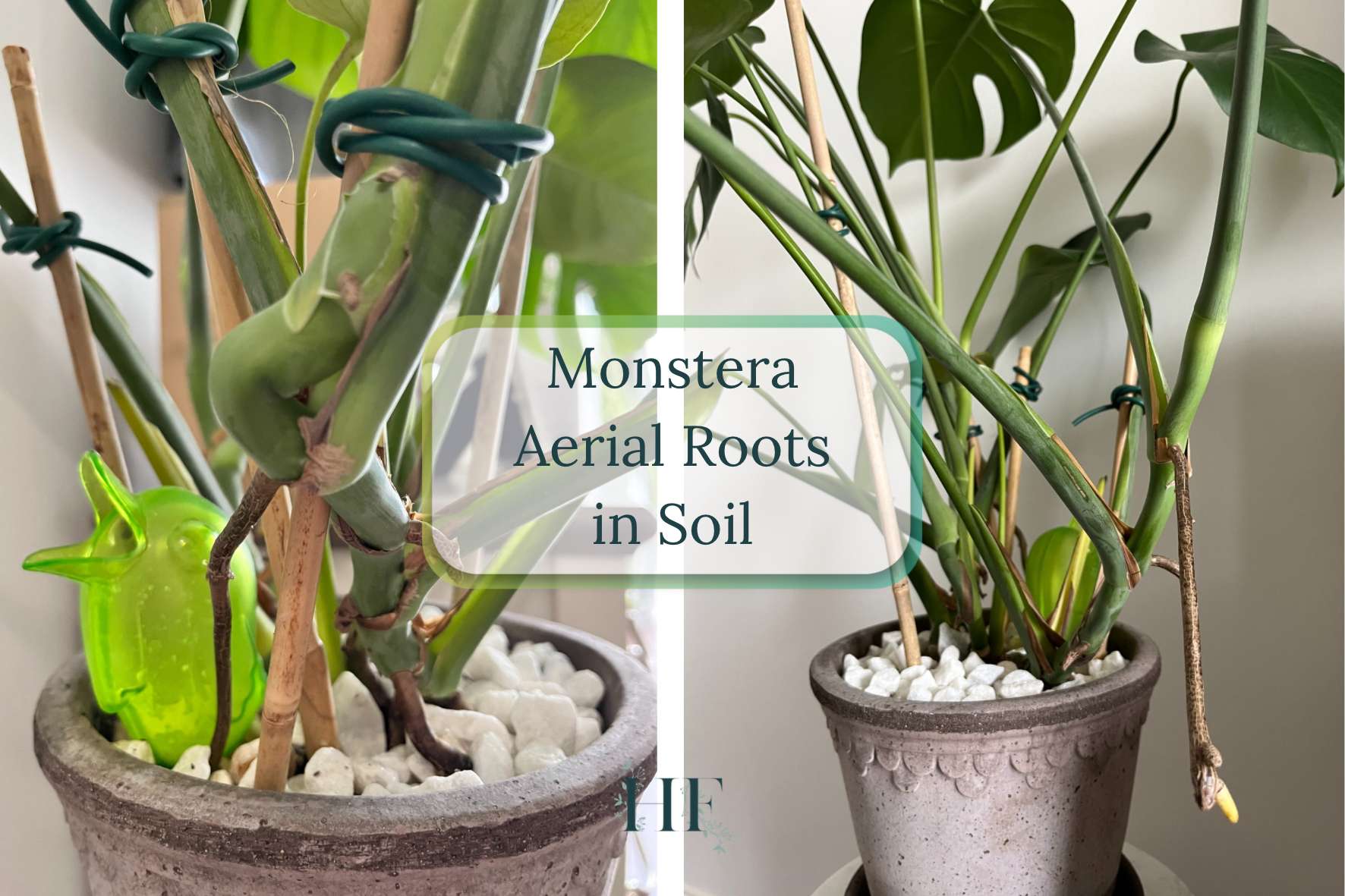
11) Why Are My Monstera Roots Shrivelling (Drying Out)?
It’s natural for mature aerial roots in Monstera Deliciosa to turn brown and woody. But, it doesn’t mean that your Monstera’s aerial roots are shrivelling.
Unlike orchid aerial roots (which will shrivel up, i.e. dry up, if they don’t have enough moisture), Monstera aerial roots are different.
If you find that an aerial root is shrivelling (wrinkling up, especially due to loss of moisture), inspect it to see if there was any physical damage done to it. If that’s the case, simply trim off the dried part of the aerial root.
Do you have any other questions that I did not cover in this post? Comment below, I’d love to help 🙂

